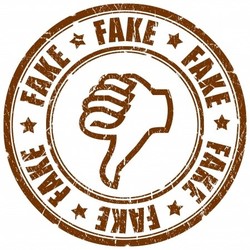 Over the last 35 years, I have witnessed firsthand many drastic changes in the manufacturing industry, but nothing has ever compared to the entrance of counterfeiting. However, the criminal underground should not be exclusively faulted, because the manufacturing industry has unwittingly but directly contributed to the explosive growth of the counterfeit and the gray market (a system of trade that’s unauthorized, unofficial and frowned upon, but not illegal).
Over the last 35 years, I have witnessed firsthand many drastic changes in the manufacturing industry, but nothing has ever compared to the entrance of counterfeiting. However, the criminal underground should not be exclusively faulted, because the manufacturing industry has unwittingly but directly contributed to the explosive growth of the counterfeit and the gray market (a system of trade that’s unauthorized, unofficial and frowned upon, but not illegal).
Historically, the growth of the global counterfeiting industry has been attributed to seven driving forces, including:
- A slumping economy
- Low-cost, advanced technology
- Trade globalization
- Consumer complicity
- Channel and market expansion
- Powerful global brands
- Weak international regulations and enforcement
The explosive growth in counterfeiting is mainly attributed to the digital era, as the Internet turned counterfeiting into a low-risk market by affording counterfeiters a nearly unlimited global market, low-cost communications and potential anonymity. Additionally, the general practice of information sharing allows counterfeiters to readily access proprietary information and ultimately capitalize on the demand for high-end brands.
Assess your vulnerabilities
Given the fragile nature of a manufacturer’s most valuable equity, seasoned supply chain leaders shouldn’t be surprised by the emergence of brand counterfeiting. As a whole, the manufacturing industry’s efforts to protect intellectual property (IP) have been ineffective thus far. Even the most highly regarded global organizations have shared their standard operating procedures (SOPs) with external parties, trained them on quality manufacturing and even transferred tooling and printing plates. To truly mitigate the risks of counterfeiting, manufacturers must objectively assess the effectiveness of their existing efforts by considering the following:
- Do we conduct due diligence in regards to contractor and employee background checks, as well as facility security, inventory accountability and destruction of unsalable materials?
- Do we regularly audit every external facility that participates in our supply chain?
- Do we ensure all of our retired tangible assets are properly destroyed and inaccessible to counterfeiters?
- Do our existing processes, procedures and knowledge enable us to trust with verification?
Companies that are unable or unwilling to address each component of this assessment are vulnerable to and likely enabling the counterfeit production of its brands.
Leveling the playing field
Though counterfeiters are reliant on a manufacturing source, they have the advantage of mimicking a legitimate brand. Fortunately, an arsenal of risk mitigating practices and countermeasures are available today and highly recommended, especially for companies in high-risk countries like China, Brazil, India or Paraguay.
Despite the available solutions, the industry will continue to struggle with counterfeiting until it properly leverages the knowledge and unique perspectives of its supply chain counterparts. Incorporating these perspectives equips companies with the ability to comply with stricter supply regulations, realize the benefits of anti-counterfeit (ACF) technologies and utilize a layered approach to secure their brands.
Diversifying and combining all of these, as well as updating tactics periodically, can drastically reduce vulnerability. However, the lack of a single entity or legislation that provides end-to-end supply chain security has led to technology experts being tapped for help with brand protection. Likewise, manufacturers are returning the favor by providing technologists with inside knowledge of the best methods for installing and integrating authentication solutions into existing SOPs.
Any expert can present a case in support of adopting ACF technology and brand protection solutions. The problem lies with manufacturers who are convinced that high supply chain visibility is detrimental to success. Likewise, traders and distributors are reluctant to share transaction records, fearing it diminishes their value as intermediaries and may result in lost business. To date, many parties in the supply chain still resist collaboration despite the harmful - or even fatal - consequences that a diluted brand can pose to the industry, supply chain, retailers and consumers.
Manufacturing executives who are hesitant to invest in fighting counterfeiting can gain confidence by adhering to these guiding principles:
Embrace the counterfeiting threat. Manufacturing leaders must accept responsibility by holding themselves accountable for supply integrity and demonstrating an awareness of the growing threat to their business, supply chain and consumer health and safety. To accomplish this, stakeholders can publicly campaign for the implementation of a zero-tolerance policy for breaches by employees, suppliers and third-party providers.
Protect IP and operational practices. Prudent operational managers and executives should focus on protecting IP and other proprietary information by increasing visibility and control of production materials throughout the supply network. Best practices for protection include:
- Instate mandatory ACF awareness training for all employees and contractors;
- Monitor supply and demand trends across trade channels for aberrations that may indicate the presence of fake goods;
- Respond aggressively to all incidents of fake goods;
- Revise third-party agreements to ensure that any transactions outside of your authorized network are explicitly forbidden;
- Authenticate returned goods before restocking and trace suspicious goods back to their sources;
- Update disposal procedures for unsalable products and retired equipment to prevent access by counterfeiters;
- Redesign facility and freight processes to ensure full asset protection; and
- Continuously purchase and authenticate your finished goods in the open market.
Anti-counterfeit technology
There are several options available for companies in need of ACF solutions. Before investing, companies can determine which ACF solution is the best fit by evaluating its supply chain’s projected risk based on three components: the brand profile, active trade channels and target markets. Unfortunately, brands in highest demand are at greater risk due to increased global counterfeit production. ACF technologies, particularly those capable of full operational integration and downstream authentication, fall into three categories:
- Sensory authentication: Overt and semi-covert packaging markings, such as holograms, color-changing inks and other sensitive materials;
- Digital authentication: Forensic markings, barcodes and taggants that authenticate via package or product scan; and
- Track & trace systems: Custom-built scanners or mobile applications that use unique identifiers to track product movement and/or retrace the chain of custody through the supply chain.
These solutions have strengths and limitations. For example, hologram authentication is relatively inexpensive, easily recognized and nearly effortless to implement by the commercial sector, but it’s also highly vulnerable to replication by counterfeiters. Digital authentication adds a layer of sophistication to the technology, but its process remains contingent on the use of a corresponding interrogating device.
Generally speaking, covert markings are more expensive to implement than its visible counterparts, and track and trace systems require the largest investment due to its multi-layer approach to security monitoring. Industries yielding high-risk goods, such as pharmaceuticals often prefer track and trace, and despite the financial drawbacks, legislators are increasingly mandating its adoption to better control the flow of goods.
Leave it to the experts
Before exploring the endless array of brand protection options and technology providers, it’s important to consult a brand specialist who can provide an objective risk assessment and help with the decision-making process. Specialists can advise on equipment specifications, such as vision systems and security materials, and their experience helps companies avoid project delays and unforeseen costs. In developing a comprehensive brand protection program, consultants can provide recommendations for the best practices, market monitoring tools and investigative support that will align with your overall strategic goals.
As criminals continue to profit off of the double-digit growth rate of counterfeit production, supply chain leaders must invest in aggressive brand protection initiatives, from auditing existing SOPs to revamping security and distribution practices and adopting ACF technology solutions. Such a commitment is mandated by the threats to consumer health and safety, as well as the potential for brand dilution.
Most importantly, is understanding that no single company, technology, practice or program will mitigate these risks alone. The most viable solution for the future of manufacturing relies on multi-lateral cooperation on all fronts, from legislators and regulators to manufacturers, distributors and retailers—even consumers have a role to play. Gaining a competitive edge is not an option when consumer safety is on the line, so despite any initial misgivings about collaborating, the industry must ultimately find success together or not at all.
 This is the second article of a three-part series, co-authored by Neil Alpert, chief executive, and Ron Guido, chief marketing officer for LaserLock Technologies.
This is the second article of a three-part series, co-authored by Neil Alpert, chief executive, and Ron Guido, chief marketing officer for LaserLock Technologies.
The first article - Exploiting Your Supply Chain: Confessions of a Counterfeiter - appeared on SecuringIndustry.com on October 20, 2013.
Image credit: arcady31 / 123RF Stock Photo
©
SecuringIndustry.com




 Over the last 35 years, I have witnessed firsthand many drastic changes in the manufacturing industry, but nothing has ever compared to the entrance of counterfeiting. However, the criminal underground should not be exclusively faulted, because the manufacturing industry has unwittingly but directly contributed to the explosive growth of the counterfeit and the gray market (a system of trade that’s unauthorized, unofficial and frowned upon, but not illegal).
Over the last 35 years, I have witnessed firsthand many drastic changes in the manufacturing industry, but nothing has ever compared to the entrance of counterfeiting. However, the criminal underground should not be exclusively faulted, because the manufacturing industry has unwittingly but directly contributed to the explosive growth of the counterfeit and the gray market (a system of trade that’s unauthorized, unofficial and frowned upon, but not illegal). This is the second article of a three-part series, co-authored by Neil Alpert, chief executive, and Ron Guido, chief marketing officer for LaserLock Technologies.
This is the second article of a three-part series, co-authored by Neil Alpert, chief executive, and Ron Guido, chief marketing officer for LaserLock Technologies.